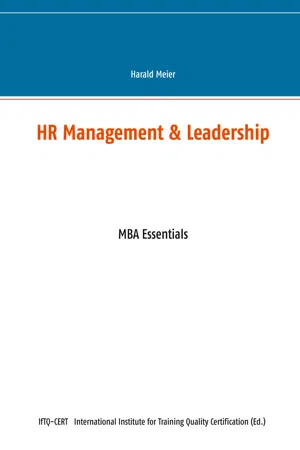Business
Employment Policy
Employment policy refers to the set of rules, guidelines, and practices established by an organization to govern its approach to hiring, managing, and terminating employees. It encompasses areas such as recruitment, compensation, benefits, performance evaluation, and disciplinary procedures. A well-defined employment policy helps ensure compliance with labor laws, promotes a positive work environment, and supports the organization's strategic objectives.
Written by Perlego with AI-assistance
Related key terms
Related key terms
1 of 4
Related key terms
1 of 3
3 Key excerpts on "Employment Policy"
- eBook - ePub
- John Stevens, Vicki Jeynes, Elvis Cotena, Mark Edelson(Authors)
- 2006(Publication Date)
- Routledge(Publisher)
Managers and employees who are clear on expected standards can be in no doubt what action should and will be taken if these are not followed. In addition, Human Resources professionals can take a proactive approach in adapting and amending policies/procedures in the future. This will help to keep the employee relations climate positive within the organisation and reduce risks. THE LINK BETWEEN EMPLOYMENT LEGISLATION AND POLICIES 4.56 In Chapter 5, we will mention the potential impact of employment legislation on the recruitment process, primarily in the area of discrimination legislation. It must also be noted, however, that discrimination legislation has an impact on the whole sphere of employment and is not just restricted to recruitment. We have also seen that employment legislation can impact on other policy areas such as disciplinary and grievance procedures. 4.57 There are, of course, other specific aspects of legislation that could require the development of policies. For example, such areas as the family-friendly policies introduced as a result of the Employment Relations Act 1999 and modified by the Employment Act 2000, redundancy, working time and holidays. 4.58 An organisation may take the view that there is no need to develop a policy since it will always operate in line with the statutory requirements. However this approach is not without risks. We will see in Chapter 5 how relatively complex the maternity leave and pay regulations are, with requirements for different actions on particular dates, otherwise employees lose entitlements. 4.59 Having no policy written down for maternity or other family-friendly policies leaves an organisation in a situation where employees may know that there is a statutory provision, but have no idea of the requirements. It is important for organisations to make their obligations and those of their employees clear. This will result in management of the individual’s expectations and ensure workplace harmony - eBook - ePub
HR Management & Leadership
MBA Essentials
- Harald Meier(Author)
- 2021(Publication Date)
- Books on Demand(Publisher)
1. HR Management Policy and Strategy- 1.1 HR Management Policy
- 1.1.1 Corporate Policy and HR Management
- 1.1.2 Governance, Compliance and Co-determination
- 1.1.3 HR and Leadership related Megatrends
- 1.1.4 Strategic HR and Human Capital Management
- 1.2 Concepts and Instruments of HR Policy
- 1.2.1 HR and Leadership Guidelines
- 1.2.2 Employee Relations, HR Research and Survey
- 1.2.3 Works Agreement
- 1.2.4 Employer Branding
- 1.2.5 Annual HR Report and Staff Meeting
- 1.2.6 Change Management
1.1 HR Management Policy
1.1.1 Corporate Policy and HR Management
Corporate Policy (policy : consciously enforcing will) is decision making and design of the long-term corporate goals and their adaptation to internal and external framework conditions or influences – as basis for following operationalized divisional, department etc. planning activities (see following example in the HR Division).Fig. 1.1: Corporate Business Plan and HR Management
- eBook - ePub
- Heather Falconer, Mike Bagshaw(Authors)
- 2009(Publication Date)
- Routledge(Publisher)
Chapter SixEstablishing Effective Policies Heather Falconer IntroductionHR practitioners spend a good proportion of their working lives working on one type of policy or another. The more traditional sort, with titles such as equal opportunities, sexual harassment, and diversity, are now being added to in progressive companies by initiatives on bullying, violence, whistle-blowing, alcohol and drugs, work-life balance and more.Recently, some employers have chosen to take a more all-encompassing approach to the problem of dysfunctional conflict such as bullying and harassment by introducing ‘dignity at work’ policies. These can cover a whole range of conflict issues such as discrimination, harassment, bullying, victimisation, violence. They are designed not only to condemn negative behaviours but also to reinforce the organisation’s commitment to positive values such as dignity, respect, courtesy and fairness. They are often couched in terms of the rights and responsibilities of everyone in the workplace.The impetus for many such policies has been the perceived threat of tribunal claims and the growing likelihood of an employer being held vicariously liable for the illegal acts of its employees: organisations have long been advised that having a clear policy on issues such as harassment and discrimination will reduce the possibility of having to foot the bill.But this is not all. The past few years has seen a growth in understanding of how fair and ethical employment policies affect employee commitment, loyalty, motivation and retention. The government’s Workplace Employee Relations Survey, for example, has found that progressive employment practices result in higher productivity and morale among workers. The growing problems of stress-related illness and absenteeism have also forced some employers to confront the conflict issues causing staff to suffer sustained high levels of anxiety.
Index pages curate the most relevant extracts from our library of academic textbooks. They’ve been created using an in-house natural language model (NLM), each adding context and meaning to key research topics.
Explore more topic indexes
Explore more topic indexes
1 of 6
Explore more topic indexes
1 of 4


